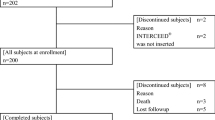Abstract
Purpose
The spray-type adhesion barrier “AdSpray®” can be easily used even in a small abdominal cavity. However, there have been no reports on the safety and efficacy of its application in children. We retrospectively examined the safety and efficacy of AdSpray® in pediatric laparoscopic surgery.
Methods
We performed a retrospective review of all patients < 18 years old for whom AdSpray® was used in laparoscopic surgery at our institution between September 2017 and December 2021. As postoperative adverse events, intra-abdominal abscess, peritonitis and wound infection were evaluated. The morbidity of ileus during the postoperative follow-up period was also evaluated. Liver enzymes and the renal function before and after surgery were analyzed.
Results
A total of 64 children underwent laparoscopic surgery and simultaneous AdSpray® treatment. There were 48 children < 6 years old. There were no allergic symptoms or inflammatory reactions, liver dysfunction or renal dysfunction during and the stable period after surgery. Three patients with adhesive ileus who underwent laparoscopic surgery using AdSpray® did not show recurrent ileus in over three year of clinical follow-up.
Conclusion
This study investigated the safety and efficacy of AdSpray® in pediatric laparoscopic surgery, and no adverse events associated with AdSpray® usage were confirmed.


Similar content being viewed by others
Availability of data and materials
The data that support the findings of this study are available from the corresponding author upon reasonable request.
References
Molinaro F, Kaselas C, Lacreuse I, Moog R, Becmeur F (2009) Postoperative intestinal obstruction after laparoscopic versus open surgery in the pediatric population: a 15-year review. Eur J Pediatr Surg 19:160–162
Jolley SG, Tunell WP, Hoelzer DJ, Smith EI (1986) Postoperative small bowel obstruction in infants and children: a problem following Nissen fundoplication. J Pediatr Surg 21:407–409
Wilkins BM, Spitz L (1987) Adhesion obstruction following Nissen fundoplication in children. Br J Surg 74:777–779
Tsao KJ, St Peter SD, Valusek PA et al (2007) Adhesive small bowel obstruction after appendectomy in children: comparison between the laparoscopic and open approach. J Pediatr Surg 42:939–942
Linden BC, Bairdain S, Zurakowski D, Shamberger RC, Lillehei CW (2013) Comparison of laparoscopic-assisted and open total proctocolectomy and ileal pouch anal anastomosis in children and adolescents. J Pediatr Surg 48:1546–1550
Suto T, Watanabe M, Endo T et al (2017) The primary result of prospective randomized multicenter trial of new spray-type bio-absorbable adhesion barrier system (TCD-11091) against postoperative adhesion formation. J Gastrointest Surg 21:1683–1691
Kanda Y (2013) Investigation of the freely available easy-to-use software “EZR” for medical statistics. Bone Marrow Transplant 48:452–458
Cezar C, Korell M, Tchartchian G et al (2016) How to avoid risks for patients in minimal-access trials: avoiding complications in clinical first-in-human studies by example of the ADBEE study. Best Pract Res Clin Obstet Gynaecol 35:84–96
Cezar C, Tchartchian G, Korell M et al (2016) Long term follow-up concerning safety and efficacy of novel adhesion prophylactic agent for laparoscopic myomectomy in the prospective randomized ADBEE study. Best Pract Res Clin Obstet Gynaecol 35:97–112
Kai M, Maeda K, Tasaki M et al (2018) Evaluation of a spray-type, novel dextrin hydrogel adhesion barrier under laparoscopic conditions in a porcine uterine horn adhesion model. J Minim Invasive Gynecol 25:447–454
Park EY, Kwon JY, Kim KJ (2012) Carbon dioxide embolism during laparoscopic surgery. Yonsei Med J 53:459–466
Amin MD, Harpavat S, Leung DH (2015) Drug-induced liver injury in children. Curr Opin Pediatr 27:625–633
Patzer L (2008) Nephrotoxicity as a cause of acute kidney injury in children. Pediatr Nephrol 23:2159–2173
Okubo S, Shindoh J, Kobayashi Y, Matsumura M, Hashimoto M (2021) Adhesions as a risk factor for postoperative morbidity in patients undergoing repeat hepatectomy and the potential efficacy of adhesion barriers. J Hepatobiliary Pancreat Sci 29:618–628
Acknowledgements
We appreciate Mr. Brian Quinn for his advices and help with the manuscript.
Funding
The authors did not receive support from any organization for the submitted work.
Author information
Authors and Affiliations
Contributions
MM and KS drafted the manuscript and equally contributed to this study. SI and TK supervised the writing of the manuscript. YI, MO, LT, NN, AN, KY, SO, TH, KY WY, MM, TK and MM performed surgery and perioperative management of the patient. All authors read and approved the final manuscript.
Corresponding author
Ethics declarations
Conflict of interests
The authors have no conflicts of interest to declare with regard to this manuscript.
Ethics approval and consent to participate
This study was performed in accordance with the Ethical Guidelines for Medical and Health Research Involving Human Subjects by the Ministry of Health, Labour, and Welfare of Japan in 2014. The study complied with the 1964 Declaration of Helsinki (revised in 2013) and was approved by the local ethics committee of Kagoshima University Hospital (registration number: 27-119). All participants, or their parents, provided their informed consent for inclusion for publication of this article and any companying images.
Consent for publication
Not applicable.
Rights and permissions
Springer Nature or its licensor (e.g. a society or other partner) holds exclusive rights to this article under a publishing agreement with the author(s) or other rightsholder(s); author self-archiving of the accepted manuscript version of this article is solely governed by the terms of such publishing agreement and applicable law.
About this article
Cite this article
Murakami, M., Sugita, K., Iwamoto, Y. et al. Safety of the spray-type adhesion barrier “AdSpray®”in pediatric laparoscopic surgery. J Ped Endosc Surg (2024). https://doi.org/10.1007/s42804-024-00226-y
Received:
Revised:
Accepted:
Published:
DOI: https://doi.org/10.1007/s42804-024-00226-y




